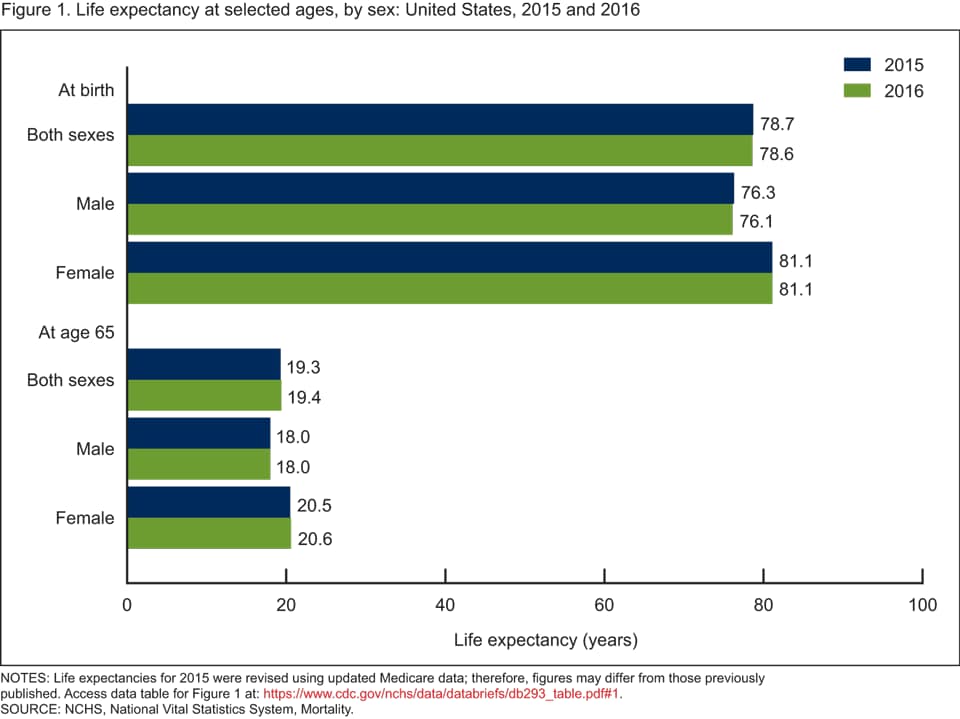Q and As on “Mortality in the United States, 2016” and “Drug Overdose Deaths in the United States, 1999-2016”
Posted on byQuestions for Bob Anderson, Chief of the Mortality Statistics Branch, on the following reports, “Mortality in the United States, 2016” and “Drug Overdose Deaths in the United States, 1999-2016.”
Q: How significant is it that life expectancy¹ in the U.S. has declined two years in a row?
A: This is the first time life expectancy for the U.S. as a whole has declined two years in a row since 1962 and 1963, years in which there were severe flu outbreaks – and an increase in deaths from flu and pneumonia – in the U.S.
Q: Since this is very rare, do we have any idea why this decline in life expectancy has happened again?
A: We first have to look at the leading causes of death and see what is happening there. For 7 out of the 10 leading causes of death in the U.S., mortality actually declined between 2015 and 2016. But mortality from 3 causes of deaths increased. Suicide rates increased 1.5% in 2016, and mortality from Alzheimer’s disease increased 3.1%. However, mortality from accidents/unintentional injuries increased at a rate over three times that the increase of Alzheimer’s disease mortality – a 9.7% increase between 2015 and 2016. And many of these accidental/unintentional deaths were from drug overdoses.
Q: How many deaths in 2016 were attributed to opioids?
A: In 2016, 42,249 drug overdose deaths mentioned involvement of any type of opioid, including heroin and illicit opioids.
Q: Why is the 63,632 number of overdose deaths smaller than what CDC has previously reported for 2016?
A: The 63,632 number is a final, official number of overdose deaths among U.S. residents for 2016 whereas the previously reported (and slightly higher) numbers were provisional estimates.
BACKGROUND: In August of this year, CDC began calculating monthly provisional data on counts of drug overdose deaths as a rapid response to this public health crisis, in order to provide a more accurate, closer to “real-time” look at what is happening both nationally and at the state level. These monthly totals are provisional counts, and they include all deaths occurring in the U.S. – which include deaths among non-residents (i.e., visitors here on business or leisure, students from abroad, etc). These counts also do not include deaths that are still under investigation. As a result, the monthly numbers are provisional or very preliminary, and the final 2016 number of 63,632 deaths is an official number that only include deaths among U.S. residents and account for any previously unresolved deaths that were under investigation.
Q: In comparing the 2016 numbers with 2015 and past years, is the crisis of drug overdose deaths growing or about the same?
A: From 2015 to 2016, the number of drug overdose deaths increased from 52,404 deaths to 63,632 deaths, a 21% increase. Over a longer period of time, from 1999 through 2016, the age-adjusted rate of drug overdose deaths increased on average by 10% per year from 1999 to 2006, by 3% per year from 2006 to 2014, and by 18% per year from 2014 to 2016. So this is a continuing, disturbing upward trend.
Q: Are there any other trends of significance when looking at the types of drugs attributed to overdose deaths?
A: The rate of drug overdose deaths involving synthetic opioids other than methadone, which include drugs such as fentanyl, fentanyl analogs, and tramadol, doubled in one year, from 3.1 per 100,000 in 2015 to 6.2 per 100,000 in 2016. In 2016, 30% of all drug overdose deaths mentioned involvement of a synthetic opioid other than methadone.
Q: Has fentanyl overtaken heroin as a major cause of overdose death?
A: The data brief on drug overdose deaths does not specifically address fentanyl. However the rate of drug overdose deaths involving synthetic opioids other than methadone, which includes fentanyl, doubled between 2015 and 2016. In 2016, the rate of drug overdose deaths involving synthetic opioids other than methadone was 6.2 per 100,000 and the rate of drug overdose deaths involving heroin was 4.9 per 100,000.
Q: There is a lot of stark news in these two reports. Are there any positives to report?
A: As mentioned, mortality from 7 out of the 10 leading causes of death in the U.S. declined in 2016; in fact, the overall mortality rate for the U.S. actually dropped despite the decline in life expectancy. As for drug overdose deaths, the rate of increase in drug overdose deaths involving natural and semi-synthetic opioids, such as oxycodone and hydrocodone, is slowing. From 1999 to 2009, the rate increased on average by 13% per year but from 2009 to 2016, the rate increased by 3% per year. And from 2006 to 2016, the rate of drug overdose deaths involving methadone decreased from 1.8 per 100,000 to 1.0 per 100,000.
The 2015 life expectancy estimate was revised to 78.7 years, down from 78.8 years, which was reported a year ago.
¹BACKGROUND: As a routine matter, for the highest degree of accuracy we blend Medicare data for people ages 66 and over with our vital statistics data to get a final, official estimate of life expectancy. However, the two data sets are released on different schedules and occasionally, as with the 2015 estimates, the Medicare data for that year isn’t available at the time we release our final mortality statistics.
Posted on by


